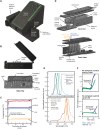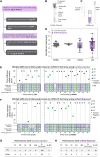Harmony COVID-19: A ready-to-use kit, low-cost detector, and smartphone app for point-of-care SARS-CoV-2 RNA detection
- PMID: 34910507
- PMCID: PMC8673764
- DOI: 10.1126/sciadv.abj1281
Harmony COVID-19: A ready-to-use kit, low-cost detector, and smartphone app for point-of-care SARS-CoV-2 RNA detection
Abstract
RNA amplification tests sensitively detect severe acute respiratory syndrome coronavirus 2 (SARS-CoV-2) infection, but their complexity and cost are prohibitive for expanding coronavirus disease 2019 (COVID-19) testing. We developed “Harmony COVID-19,” a point-of-care test using inexpensive consumables, ready-to-use reagents, and a simple device. Our ready-to-use, multiplexed reverse transcription, loop-mediated isothermal amplification (RT-LAMP) can detect down to 0.38 SARS-CoV-2 RNA copies/μl and can report in 17 min for high–viral load samples (5000 copies/μl). Harmony detected 97 or 83% of contrived samples with ≥0.5 viral particles/μl in nasal matrix or saliva, respectively. Evaluation in clinical nasal specimens (n = 101) showed 100% detection of RNA extracted from specimens with ≥0.5 SARS-CoV-2 RNA copies/μl, with 100% specificity in specimens positive for other respiratory pathogens. Extraction-free analysis (n = 29) had 95% success in specimens with ≥1 RNA copies/μl. Usability testing performed first time by health care workers showed 95% accuracy.
Figures








References
-
- World Health Organization, WHO Coronavirus (COVID-19) Dashboard (2021); https://covid19.who.int/.
-
- A. Sandford, Coronavirus: Half of humanity now on lockdown as 90 countries call for confinement (Euronews, 2021); www.euronews.com/2020/04/02/coronavirus-in-europe-spain-s-death-toll-hit....
-
- Teran R. A., Walblay K. A., Shane E. L., Xydis S., Gretsch S., Gagner A., Samala U., Choi H., Zelinski C., Black S. R., Postvaccination SARS-CoV-2 infections among skilled nursing facility residents and staff members - Chicago, Illinois, December 2020-March 2021. MMWR Morb. Mortal. Wkly Rep. 70, 632–638 (2021). - PMC - PubMed
Grants and funding
LinkOut - more resources
Full Text Sources
Research Materials
Miscellaneous

